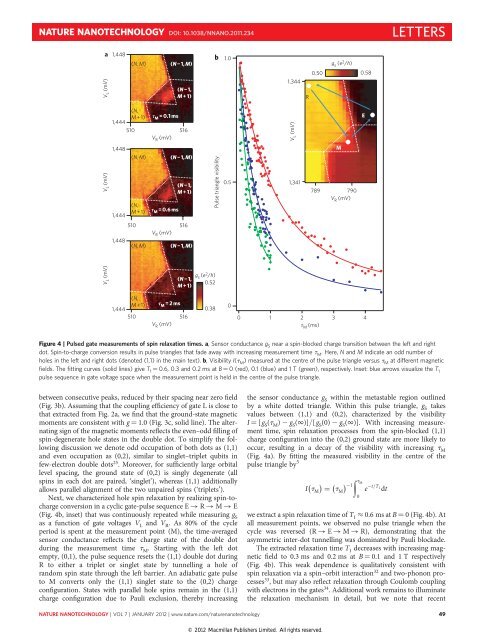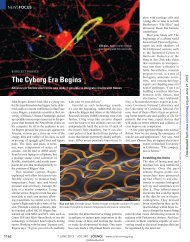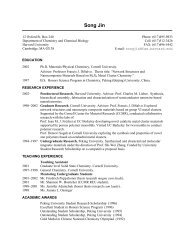Hole spin relaxation in Ge-Si core-shell nanowire qubits - Lieber ...
Hole spin relaxation in Ge-Si core-shell nanowire qubits - Lieber ...
Hole spin relaxation in Ge-Si core-shell nanowire qubits - Lieber ...
Create successful ePaper yourself
Turn your PDF publications into a flip-book with our unique Google optimized e-Paper software.
NATURE NANOTECHNOLOGY DOI: 10.1038/NNANO.2011.234<br />
LETTERS<br />
a<br />
V L (mV)<br />
1,448<br />
(N, M) (N − 1, M)<br />
(N − 1,<br />
M + 1)<br />
b<br />
1.0<br />
1,344<br />
R<br />
0.50<br />
g s (e 2 /h)<br />
0.58<br />
(N,<br />
M + 1)<br />
1,444<br />
510<br />
τ M = 0.1 ms<br />
V R (mV)<br />
516<br />
V L (mV)<br />
E<br />
V L (mV)<br />
1,448<br />
(N, M) (N − 1, M)<br />
(N − 1,<br />
M + 1)<br />
(N,<br />
M + 1)<br />
τ M = 0.6 ms<br />
1,444<br />
510<br />
516<br />
V R (mV)<br />
1,448<br />
(N, M) (N − 1, M)<br />
Pulse triangle visibility<br />
0.5<br />
1,341<br />
M<br />
789 790<br />
V R (mV)<br />
V L (mV)<br />
(N − 1,<br />
M + 1)<br />
g s (e 2 /h)<br />
0.52<br />
(N,<br />
M + 1)<br />
1,444<br />
510<br />
τ M = 2 ms<br />
V R (mV)<br />
516<br />
0.38<br />
0<br />
0<br />
1<br />
2<br />
τ M (ms)<br />
3<br />
4<br />
Figure 4 | Pulsed gate measurements of <strong>sp<strong>in</strong></strong> <strong>relaxation</strong> times. a, Sensor conductance g S near a <strong>sp<strong>in</strong></strong>-blocked charge transition between the left and right<br />
dot. Sp<strong>in</strong>-to-charge conversion results <strong>in</strong> pulse triangles that fade away with <strong>in</strong>creas<strong>in</strong>g measurement time t M . Here, N and M <strong>in</strong>dicate an odd number of<br />
holes <strong>in</strong> the left and right dots (denoted (1,1) <strong>in</strong> the ma<strong>in</strong> text). b, Visibility I(t M ) measured at the centre of the pulse triangle versus t M at different magnetic<br />
fields. The fitt<strong>in</strong>g curves (solid l<strong>in</strong>es) give T 1 ¼ 0.6, 0.3 and 0.2 ms at B ¼ 0 (red), 0.1 (blue) and 1 T (green), respectively. Inset: blue arrows visualize the T 1<br />
pulse sequence <strong>in</strong> gate voltage space when the measurement po<strong>in</strong>t is held <strong>in</strong> the centre of the pulse triangle.<br />
between consecutive peaks, reduced by their spac<strong>in</strong>g near zero field<br />
(Fig. 3b). Assum<strong>in</strong>g that the coupl<strong>in</strong>g efficiency of gate L is close to<br />
that extracted from Fig. 2a, we f<strong>in</strong>d that the ground-state magnetic<br />
moments are consistent with g ¼ 1.0 (Fig. 3c, solid l<strong>in</strong>e). The alternat<strong>in</strong>g<br />
sign of the magnetic moments reflects the even–odd fill<strong>in</strong>g of<br />
<strong>sp<strong>in</strong></strong>-degenerate hole states <strong>in</strong> the double dot. To simplify the follow<strong>in</strong>g<br />
discussion we denote odd occupation of both dots as (1,1)<br />
and even occupation as (0,2), similar to s<strong>in</strong>glet–triplet <strong>qubits</strong> <strong>in</strong><br />
few-electron double dots 25 . Moreover, for sufficiently large orbital<br />
level spac<strong>in</strong>g, the ground state of (0,2) is s<strong>in</strong>gly degenerate (all<br />
<strong>sp<strong>in</strong></strong>s <strong>in</strong> each dot are paired, ‘s<strong>in</strong>glet’), whereas (1,1) additionally<br />
allows parallel alignment of the two unpaired <strong>sp<strong>in</strong></strong>s (‘triplets’).<br />
Next, we characterized hole <strong>sp<strong>in</strong></strong> <strong>relaxation</strong> by realiz<strong>in</strong>g <strong>sp<strong>in</strong></strong>-tocharge<br />
conversion <strong>in</strong> a cyclic gate-pulse sequence E → R → M → E<br />
(Fig. 4b, <strong>in</strong>set) that was cont<strong>in</strong>uously repeated while measur<strong>in</strong>g g S<br />
as a function of gate voltages V L and V R . As 80% of the cycle<br />
period is spent at the measurement po<strong>in</strong>t (M), the time-averaged<br />
sensor conductance reflects the charge state of the double dot<br />
dur<strong>in</strong>g the measurement time t M . Start<strong>in</strong>g with the left dot<br />
empty, (0,1), the pulse sequence resets the (1,1) double dot dur<strong>in</strong>g<br />
R to either a triplet or s<strong>in</strong>glet state by tunnell<strong>in</strong>g a hole of<br />
random <strong>sp<strong>in</strong></strong> state through the left barrier. An adiabatic gate pulse<br />
to M converts only the (1,1) s<strong>in</strong>glet state to the (0,2) charge<br />
configuration. States with parallel hole <strong>sp<strong>in</strong></strong>s rema<strong>in</strong> <strong>in</strong> the (1,1)<br />
charge configuration due to Pauli exclusion, thereby <strong>in</strong>creas<strong>in</strong>g<br />
the sensor conductance g S with<strong>in</strong> the metastable region outl<strong>in</strong>ed<br />
by a white dotted triangle. With<strong>in</strong> this pulse triangle, g S takes<br />
values between (1,1) and (0,2), characterized by the visibility<br />
I ¼ [g S (t M ) 2 g S (1)]/[g S (0) 2 g S (1)]. With <strong>in</strong>creas<strong>in</strong>g measurement<br />
time, <strong>sp<strong>in</strong></strong> <strong>relaxation</strong> processes from the <strong>sp<strong>in</strong></strong>-blocked (1,1)<br />
charge configuration <strong>in</strong>to the (0,2) ground state are more likely to<br />
occur, result<strong>in</strong>g <strong>in</strong> a decay of the visibility with <strong>in</strong>creas<strong>in</strong>g t M<br />
(Fig. 4a). By fitt<strong>in</strong>g the measured visibility <strong>in</strong> the centre of the<br />
pulse triangle by 5<br />
∫<br />
( ) ( ) tM<br />
−1<br />
I t M = tM e −t/T 1<br />
dt<br />
0<br />
we extract a <strong>sp<strong>in</strong></strong> <strong>relaxation</strong> time of T 1 ≈ 0.6 ms at B ¼ 0 (Fig. 4b). At<br />
all measurement po<strong>in</strong>ts, we observed no pulse triangle when the<br />
cycle was reversed (R → E → M → R), demonstrat<strong>in</strong>g that the<br />
asymmetric <strong>in</strong>ter-dot tunnell<strong>in</strong>g was dom<strong>in</strong>ated by Pauli blockade.<br />
The extracted <strong>relaxation</strong> time T 1 decreases with <strong>in</strong>creas<strong>in</strong>g magnetic<br />
field to 0.3 ms and 0.2 ms at B ¼ 0.1 and 1 T respectively<br />
(Fig. 4b). This weak dependence is qualitatively consistent with<br />
<strong>sp<strong>in</strong></strong> <strong>relaxation</strong> via a <strong>sp<strong>in</strong></strong>–orbit <strong>in</strong>teraction 32 and two-phonon processes<br />
33 , but may also reflect <strong>relaxation</strong> through Coulomb coupl<strong>in</strong>g<br />
with electrons <strong>in</strong> the gates 34 . Additional work rema<strong>in</strong>s to illum<strong>in</strong>ate<br />
the <strong>relaxation</strong> mechanism <strong>in</strong> detail, but we note that recent<br />
NATURE NANOTECHNOLOGY | VOL 7 | JANUARY 2012 | www.nature.com/naturenanotechnology 49<br />
© 2012 Macmillan Publishers Limited. All rights reserved.







